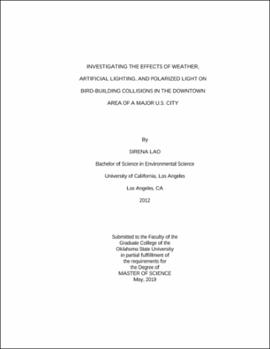| dc.contributor.advisor | Loss, Scott | |
| dc.contributor.author | Lao, Sirena | |
| dc.date.accessioned | 2023-09-21T18:57:25Z | |
| dc.date.available | 2023-09-21T18:57:25Z | |
| dc.date.issued | 2019-05 | |
| dc.identifier.uri | https://hdl.handle.net/11244/339607 | |
| dc.description.abstract | Collisions with buildings are a major source of human-caused mortality of birds, killing up to 1 billion birds annually in the United States. Most bird-building collision studies have focused on building and landscape-related factors that contribute to collisions, such as glass area and the amount of surrounding vegetation. Some studies have also considered characteristics of birds, such as migratory behavior and feeding habits, that cause some groups to be more vulnerable to collisions. Nocturnally migrating birds are especially susceptible to collisions, and the combination of poor weather conditions and artificial light at night (ALAN) is frequently cited as causing large collision events. However, little research has formally analyzed these factors. As part of a study evaluating collisions at 21 buildings in downtown Minneapolis, Minnesota, USA, we assessed the effects of nightly weather conditions on collisions across all study buildings. We also evaluated the relationship between collisions and two types of light pollution—ALAN and polarized light pollution (PLP), which has never been analyzed as a collision factor—at 48 façades of 13 buildings. | |
| dc.description.abstract | For weather, we found that favorable migration conditions (e.g., tailwinds) early in the night and poor weather conditions (e.g., low clouds) later in the night correlated with collisions. We also found that time lag effects (conditions from one and two additional nights before surveys) were especially important in the spring, while collisions were primarily associated with weather conditions from the night before surveys in the fall. These results provide support for using weather and bird migration forecasts to predict collisions, allowing advance action to be taken to reduce collisions. | |
| dc.description.abstract | For light pollution, we found that the area of windows emitting ALAN and the proportion of lighted glass were important factors influencing collisions, even after accounting for glass area. This result provides strong support for turning off lights at night to reduce bird-building collisions. We found no relationship between PLP and collisions, but additional research is needed to better understand bird responses to PLP. Nonetheless, reducing both types of light pollution by turning off lights and reducing reflective surfaces should contribute to significantly reducing bird-building collisions. | |
| dc.format | application/pdf | |
| dc.language | en_US | |
| dc.rights | Copyright is held by the author who has granted the Oklahoma State University Library the non-exclusive right to share this material in its institutional repository. Contact Digital Library Services at lib-dls@okstate.edu or 405-744-9161 for the permission policy on the use, reproduction or distribution of this material. | |
| dc.title | Investigating the effects of weather, artificial lighting, and polarized light on bird-building collisions in the downtown area of a major U.S. City | |
| dc.contributor.committeeMember | O'Connell, Timothy | |
| dc.contributor.committeeMember | Robertson, Bruce | |
| osu.filename | Lao_okstate_0664M_16159.pdf | |
| osu.accesstype | Open Access | |
| dc.type.genre | Thesis | |
| dc.type.material | Text | |
| thesis.degree.discipline | Natural Resource Ecology and Management | |
| thesis.degree.grantor | Oklahoma State University | |
